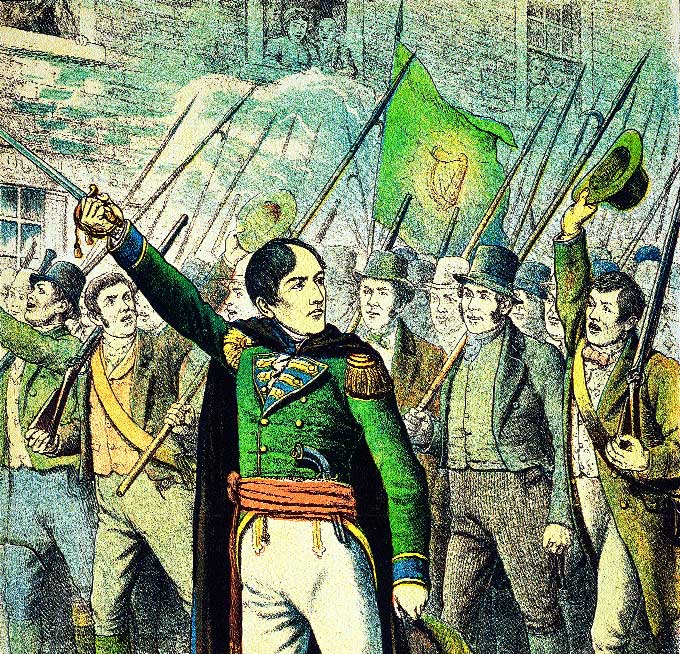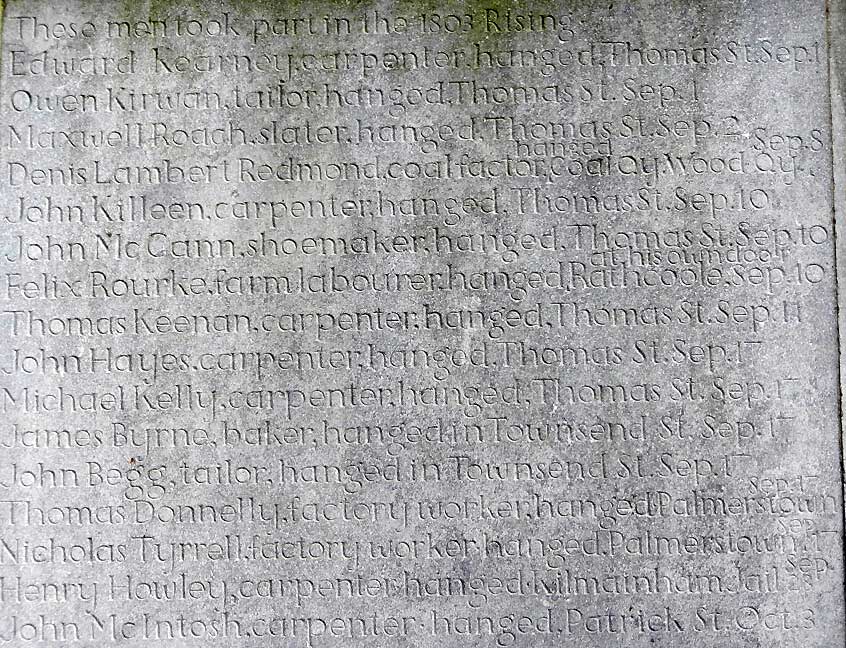Over 30 years of anarchist writing from Ireland listed under hundreds of topics
The 1803 rebellion Ireland and Robert Emmet
 The 1803 rebellion followed only five years after the rebellion of 1798. 1798 involved tens of thousands under arms, rising across the country over months and the liberation of parts of Wexford, Wicklow and Waterford for long enough for a republic to be declared. It was smashed by the British empire with great brutality directed at those under arms but also the civilian populations. As many as 30,000 may have died.
The 1803 rebellion followed only five years after the rebellion of 1798. 1798 involved tens of thousands under arms, rising across the country over months and the liberation of parts of Wexford, Wicklow and Waterford for long enough for a republic to be declared. It was smashed by the British empire with great brutality directed at those under arms but also the civilian populations. As many as 30,000 may have died.
Despite this Robert Emmet who was the brother of one of the 1798 leaders reorganised and with Thomas Russell and others attempted another rebellion in 1803.
Russell was one of the original group of United Irishmen who swore the Cave hill oath in 1795 to “never to desist in our effort until we had subverted the authority of England over our country and asserted her independence.” Russell was also an active slave-trade abolitionist who “abstained from the use of slave labour produce until slavery in the West Indies was abolished, and at the dinner parties to which he was so often invited and when confectionery was so much used he would not take anything with sugar in it.”
Russell survived the 1798 rebellion because he had been interned from 1796 following the publication of his pamphlet “A Letter to the People of Ireland on the Present Situation of the Country” and was exiled after 1798. But rather than giving up he returned to Ireland in March of 1803 and tried to encourage the north to rise with Emmet in Dublin. That rising quickly collapsed and Russell was captured some weeks later to be, like Emmet, ‘hung, drawn and quartered’ but at Downpatrick rather than Dublin.
Russell was remembered in Florence Wilson’s ballad “The Man from God Knows Where” the verses below talk of his organising in the north in the 1790s before ending with his execution in 1803. The full version can be found on the Dick Gaughan song archive.
Into our townlan’, on a night of snow,
Rode a man from God-knows-where;
None of us bade him stay or go,
Nor deemed him friend, nor damned him foe,
But we stabled his big roan mare:
For in our townlan’ we’re a decent folk,
And if he didn’t speak, why, none of us spoke,
And we sat till the fire burned low . . .
….
Two winters more, then the Trouble Year,
When the best that a man could feel
Was the pike that he kept in hidlin’s near,
Till the blood o’ hate an’ the blood o’ fear
Would be redder nor rust on the steel.
Us ones quit from mindin’ the farms,
Let them take what we gave wi’ the weight o’ our arms,
From Saintfield to Kilkeel.
In the time o the hurry, tho we had no lead
We all of us fought with the rest
An if e'er a one shook like a tremblin reed
None of us gave neither hint nor heed,
Nor even showed we'd guessed.
We men of the North had a word to say,
An we said it then, in our own dour way,
An we spoke as we thought was best.
….
By Downpatrick gaol I was bound to fare
On a day I’ll remember, feth;
For when I came to the prison square
The people were waitin’ in hundreds there,
An’ you wouldn’t hear stir nor breath!
For the sodgers were standing, grim an’ tall
Round a scaffold built there fornent the wall
An’ a man stepped out for death!
I was brave an’ near to the edge of the throng,
Yet I knowed the face again,
An’ I knowed the set, an’ I knowed the walk
An’ the sound of his strange up-country talk,
For he spoke out right an’ plain.
Then he bowed his head to the swinging rope,
Whiles I said “Please God” to his dying hope
And “Amen” to his dying prayer,
That the Wrong would cease and the Right prevail.
For the man that they hanged at Downpatrick Jail
Was the Man from God-knows-where!
Back in Dublin Emmet was part of the a process of secretly reorganising and rearming the United Irishmen. This was centred in the Dublin working class, in particular the artisans and labourers who worked and lived in and around the Liberties. They were manufacturing hinged pikes that could be hidden under coats, hand grenades and even rockets. Emmet was also meeting Michael Dwyer, who had continued the 1798 rebellion in the mountains of Wicklow and whose forces Emmet hoped to involve in the Dublin revolt.
After the defeat of 1803 nationalists mythologised the rebellion as a glorious gesture which was always doomed to failed but which kept the flame alive. In fact as Ruan O’Donnell shows in his two volume biography of Emmett the plan was for a mass uprising intended to decapitate the British state in Ireland at the very moment of a French invasion and liberation of the country.
The United Irishmen succeeded in keeping the plans for the rising secret until there was an explosion at in one of their Dublin depots. This convinced them that they must rise as soon as possible, no doubt fuelled by having experienced the repression of 1796 that did so much to undermine 1798.
However although the vast stores of musket balls and gunpowder that had been secured they had few guns to fire them with. When the rank and file mobilising in Dublin discovered that very few guns were to be had many of them voted with their feet and returned home. The Wicklow rebels also failed to mobilise for the same reason.
Rather than the large scale rebellion co-ordinated with a French landing that had been imagined 1803 amounted to Emmett leading a relative small force of his most trusted people out of their main Marshalsea Lane depot on the 28th of July. This was swelled by additional forces who had been told to wait in pubs around the area to avoid detection. Many of these were said to have been drinking and indeed the form the rebellion took was more remembered as a riot than a rebellion.
A Dragoon was dragged from his horse and killed on Thomas street followed by the interception of a carriage and the killing of its occupants which included Lord Kilwarden, the Lord Chief Justice of Ireland. This killing is sometimes presented as ironic given that Kilwarden had a reputation as a more liberal judge but in fact he had sentenced William Orr to death in a show trial in 1797. It was widely felt that Orr was framed and that the trial was a joke so quite probably those who only a few years preciously had suffered the repression of 1798 did not view Kilwarden so kindly. Kilwarden’s daughter was spared and escorted out of the area. Emmett tried to end the rebellion at this point.
Emmett is most remembered today because of the politicisation of his trial and the version of his closing statement passed down by nationalists which ends “Let no man write my epitaph: for as no man who knows my motives dare now vindicate them. let not prejudice or ignorance asperse them. Let them and me repose in obscurity and peace, and my tomb remain uninscribed, until other times, and other men, can do justice to my character; when my country takes her place among the nations of the earth, then, and not till then, let my epitaph be written.”
This and his youthful age means that he is remembered as a romantic figure rather than a revolutionary. The proclamation of the 1803 Rebellion with its insistence that “church lands are the property of the nation” was almost forgotten. Its a lengthy document with 30 decrees as to how the revolution is to proceed nationally that makes it clear this was not a noble gesture.
A final figure who has to be mentioned is that of another United Irish leader, Jeremy Hope who survived both 1798 and 1803. Hope was a linen weaver from Co. Down who was sent to Dublin to help organise the United Irishmen amongst the working class. He fought in the north in 1798 but refused to avail of the amnesty offered afterwards saying to do so would be “not only a recantation of one’s principles, but a tacit acquiescence in the justice of the punishment which had been inflicted on thousands of my unfortunate associates". He saw manufacturers as well as landowners as an enemy to be opposed, a very radical position at the time and wrote of his experiences some 40 years later that
“The higher ranks usurped the exclusive exercise of that privilege, as well as many other rights, by force, fraud, and fiction. By force the poor were subdued, and dispossessed of their interests in the soil; by fiction the titles of the spoilers were established; and by fraud on the productive industry of future generations the usurpation was continued.”
He considered most of the United Irish leaders to be out of touch with the exception of “Neilson, McCracken, Russell, and Emmet” saying;
“It was my settled opinion that the condition of the labouring class was the fundamental question at issue between the rulers and the people, and there could be no solid foundation for liberty, till measures were adopted that went to the root of the evil, and were specially directed to the restoration of the natural right of the people, the right of deriving a subsistence from the soil on which their labour was expended.”
There are in fact three monuments to 1803 to be found at St Catherines. The two Robert Emmet monuments out front (including the small plaque with the wrong day of execution) and in the laneway a plaque unveiled in 1980 by the ITGWU union leader Michael Mullen. This remembers what we might consider to be 15 of Hope’s men executed after 1803. Almost half of them are carpenters with a couple of tailors, a shoemaker, baker and a factory worker.

Edward Kearney, Carpenter, Hanged, Thomas St.
Owen Kirwin, Tailor, Hanged, Thomas St., Sept. 1st 1803
Maxwell Roche, Slator, Hanged, Thomas St., Sept. 2nd 1803
Denis Lambert Redmond, Coal Facer, Hanged, Coalquay, Woodquay
John Killeen, Carpenter, Hanged, Thomas St., Sept. 10th 1803
John McCann, Shoemaker, Hanged at his own doorstep, Thomas St., Sept. 10th 1803
Felix Rourke, Farm Labourer, Hanged, Rathcoole, Sept. 10th 1803
Thomas Keenan, Carpenter,Hanged, Thomas St., Sept. 11th 1803
John Hayes, Carpenter, Hanged, Thomas St., Sept. 17th 1803
Michael Kelly, Carpenter, Hanged, Thomas St., Sept. 17th 1803
James Byrne, Baker, Hanged, Townsend St., Sept. 17th 1803
John Begg, Tailor, Hanged, Palmerstown, Sept. 17th 1803
Nicholas Tyrrell, Factory Worker, Hanged, Palmerstown, Sept. 17th 1803
Henry Howley, Carpenter, Hanged, Kilmainham Jail, Sept. 20th 1803
John McIntoch, Carpenter, Hanged, Patrick St., Oct. 3rd 1803
Words: Andrew Flood (follow Andrew on Twitter)

